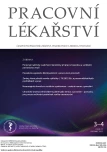Comparison of upper extremity muscle activity when working with a classic and vertical computer mouse
Authors:
B. Machová 1; L. Honzíková 1; A. Zaatar 2; J. Wrona 1; M. Janura 1,3
Authors‘ workplace:
Klinika rehabilitace a tělovýchovného lékařství, Lékařská fakulta, Ostravská univerzita, vedoucí doc. MUDr. Dalibor Pastucha, Ph. D., MBA
1; Katedra fyzioterapie, Fakulta tělesné kultury, Univerzita Palackého v Olomouci, vedoucí PhDr. David Smékal, Ph. D.
2; Katedra přírodních věd v kinantropologii, Fakulta tělesné kultury, Univerzita Palackého v Olomouci, vedoucí doc. Mgr. Zdeněk Svoboda, Ph. D.
3
Published in:
Pracov. Lék., 74, 2022, No. 3-4, s. 45-50.
Category:
Original Papers
Overview
The work deals with the description of the position of the forearm when handling different types of computer mice while working at the computer. The aim of the study was to compare the activity of selected muscles of the upper limb using surface electromyography during working at a computer while sitting with a classic and vertical computer mouse.
8 probands (age 43.1 ± 7.8 years, working at a computer 8.6 ± 1.4 hours per day) who had no previous experience with a vertical computer mouse were included in the research. A TeleMyo2400TG2 surface electromyography device with the MyoResearch version 3 program (NORAXON, USA Inc., Scottsdale, Arizona) was used to evaluate the muscle activity of selected muscles of the upper limb. The following muscles were measured (musculi): extensor carpi radialis longus, flexor carpi radialis, triceps brachii – caput laterale and caput longum, biceps brachii – common muscle belly, deltoideus – pars anterior, pars acromialis and pars posterior, trapezius – pars superior, pars medialis, pars inferior. All probands underwent two measurements with the same predetermined actions. The first measurement took place using a classic mouse. Afterwards, the probands were given HE-Mouse vertical computer mouse (R-Go Tools B.V., The Netherlands) with instructions on how to handle it. After nine months of using the vertical computer mouse, a second measurement followed.
By using the vertical computer mouse there was a significant reduction of the trapezius pars inferior muscle and the flexor carpi radialis muscle compared to a classic computer mouse.
The semi-pronated position of the forearm supported the centering of the shoulder joint and the relaxation of the hand compared to the pronated position of the forearm in a classic computer mouse. The vertical computer mouse appears to be a suitable choice for the elimination of musculoskeletal problems in the upper limb girdle area forearm and wrist for the group of probands under investigation.
Keywords:
Electromyography – Ergonomics – forearm pronation – shoulder joint – sitting
Sources
1. Conlon, C. F., Krause, N., Rempel, D. M. A randomized controlled trial evaluating an alternative mouse or forearm support on change in median and ulnar nerve motor latency at the wrist. American Journal of Industrial Medicine, 2009, 52, 4, s. 304– 310. Dostupné na www: https://doi.org/10.1002/ajim.20674.
2. Cook, C., Burgess-Limerick, R., Papalia, S. The effect of wrist rests and forearm support during keyboard and mouse use. International Journal of Industrial Ergonomics, 2004, 33, 9, s. 463–472. Dostupné na www: https://doi.org/10.1016/j.ergon. 2003.12.002
3. Ekinci, Y., Atasavun Uysal, S., Kabak, V. Y., Duger, T. Does ergonomics training have an effect on body posture during computer usage? Journal of Back and Musculoskeletal Rehabilitation, 2019, 32, 2, s. 191–195. Dostupné na www: https://doi. org/10.3233/BMR-181196.
4. Fagarasanu, M., Kumar, S. Carpal tunnel syndrome due to keyboarding and mouse tasks: A review. International Journal of Industrial Ergonomics, 2003, 31, 17, s. 119. Dostupné na www: https://doi.org/10.1016/S0169-8141(02)00180-4.
5. Gilbertová S. Muskuloskeletární obtíže při práci s počítačem. Praktický lékař, 2005, 85, 4, s. 212–214.
6. Gilbertová, S., Matoušek, O. Ergonomie – Optimalizace lidské činnosti. Praha: Grada, 2002, 239 s.
7. Gustafsson, E., Hagberg, M. Computer mouse use in two different hand positions: exposure, comfort, exertion and productivity. Applied Ergonomics, 2003, 34, 2, s. 107–113. Dostupné na www: https://doi.org/10.1016/S0003-6870(03)00005-X.
8. Maršálková, J., Malenka, P. Kazuistika – (ne)profesní syndrom karpálního tunelu. Pracovní lékařství, 2021, 73, 3–4, s. 87–90.
9. Myers, T. W. Anatomy trains: Myofascial Meridians for Manual Therapists & Movement Professionals (4th ed). Edinburgh: Elsevier Health Sciences, 2020, 378 s.
10. Quemelo, P. R. V., Vieira, E. R. Biomechanics and performance when using a standard and a vertical computer mouse. Ergonomics, 2013, 56, 8, s. 1336–1344. Dostupné na www: https:// doi.org/10.1080/00140139.2013.805251.
11. Radwan, A., Kallasy, T., Monroe, A., Chrisman, E., Carpenter, O., Jin, Z. Benefits of alternative computer mouse designs: A systematic review of controlled trials. Cogent Engineering, 2018, 5, 1, s. 107–113. Dostupné na www: https://doi.org/10.1 080/23311916.2018.1521503.
12. Schmid, A. B., Kubler, P. A., Johnston, V., Coppieters, M. W. A vertical mouse and ergonomic mouse pads alter wrist position but do not reduce carpal tunnel pressure in patients with carpal tunnel syndrome. Applied Ergonomics, 2015, 47, 8, s. 151–156. Dostupné na www: https://doi.org/10.1016/j.apergo. 2014.08.020.
Labels
Hygiene and epidemiology Hyperbaric medicine Occupational medicineArticle was published in
Occupational Medicine

2022 Issue 3-4
Most read in this issue
- Assessment of exposure to diisocyanates in the work environment
- Changes brought by the amendment to Decree 79/2022 Coll. on occupational medical examinations in practice
- Comparison of upper extremity muscle activity when working with a classic and vertical computer mouse
- prof. MUDr. Zdeněk Jirák, CSc.
